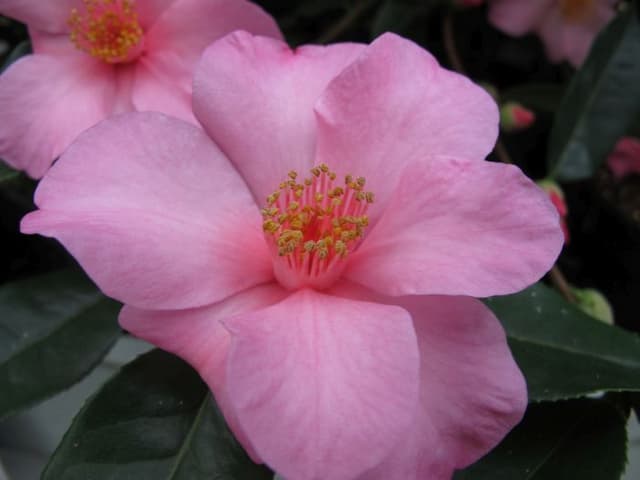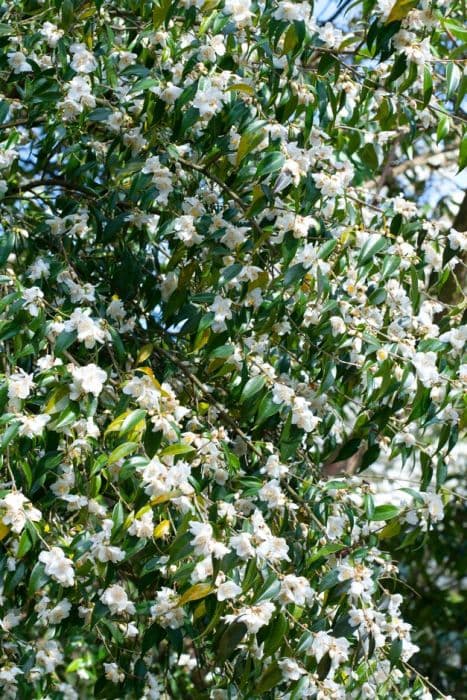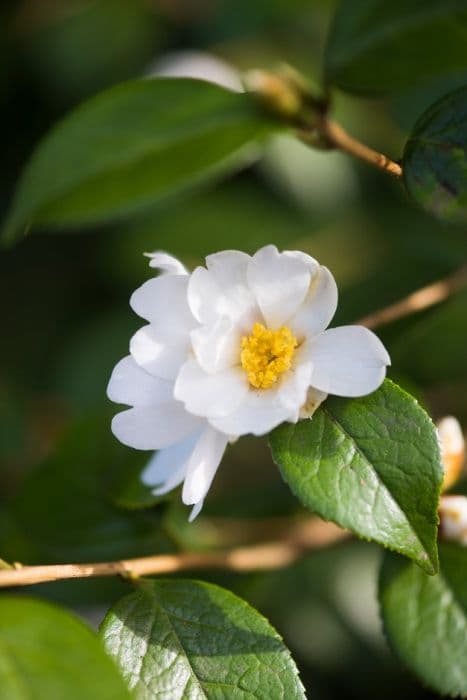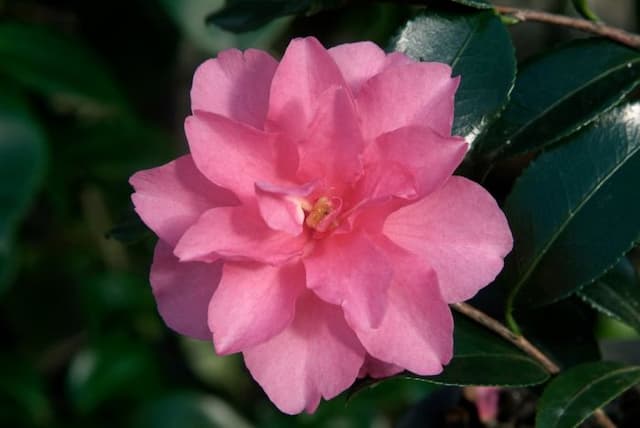Japanese Camellia Camellia japonica 'Mercury'

ABOUT
The Camellia japonica 'Mercury' is a type of flowering shrub known for its stunning blooms and lovely foliage. The flowers are the standout feature of this plant, with large, peony-like blossoms that come in a brilliant shade of red. Each flower comprises a multitude of petals that are densely packed together to form a lush, rounded bloom, creating a striking visual impact in any garden. Not only are the flowers of 'Mercury' eye-catching, but the leaves of this plant are also quite attractive. They have a glossy texture and a dark green hue, providing a perfect backdrop for the vibrant flowers. This lush foliage is typically evergreen, keeping the plant looking vibrant throughout the year. The leaves are oval-shaped with a smooth edge, adding to the plant's elegant appearance. Together, the brilliant red blooms and the rich green leaves make the Camellia japonica 'Mercury' a much-desired plant for gardeners who want to add a touch of classic beauty and year-round interest to their landscapes.
About this plant
 Names
NamesFamily
Theaceae
Synonyms
Japanese Camellia, Rose of Winter, Japonica
Common names
Camellia japonica 'Mercury'.
 Toxicity
ToxicityTo humans
Japanese camellia ('Mercury') is not considered toxic to humans. This ornamental plant, widely used in horticulture for its beautiful flowers, is generally regarded as safe. There are no well-documented cases of poisoning from ingesting Japanese camellia. However, as with any plant, individual allergies or sensitivities can occur, and it is always best to avoid eating ornamental plants.
To pets
Japanese camellia ('Mercury') is generally not toxic to pets such as dogs and cats. This plant is mainly grown for its ornamental value and is not known to cause poisoning in pets if they ingest parts of it. As with humans, pets may have individual sensitivities, and ingesting non-food plants can potentially lead to gastrointestinal upset or other symptoms in some pets, so it's best to discourage pets from consuming plant material, but serious toxicity is not expected with Japanese camellia.
 Characteristics
CharacteristicsLife cycle
Perennials
Foliage type
Evergreen
Color of leaves
Green
Flower color
Pink
Height
6-12 feet (1.8-3.7 meters)
Spread
6-10 feet (1.8-3 meters)
Plant type
Shrub
Hardiness zones
7
Native area
Asia
Benefits
 General Benefits
General Benefits- Ornamental Value: Camellia japonica 'Mercury' offers stunning, large, showy flowers that enhance the aesthetic appeal of gardens and landscapes.
- Long Blooming Season: It typically flowers from late winter to spring, providing color during a time when few other plants are in bloom.
- Evergreen Foliage: As an evergreen, it maintains its glossy, dark green leaves year-round, adding perpetual greenery to its surroundings.
- Wildlife Attraction: The flowers of the Camellia provide nectar for pollinators such as bees during the blooming season.
- Privacy Screen: Due to its dense growth habit, it can be used as a privacy screen or hedge.
- Versatility in Landscaping: Camellias can be planted as specimen plants, in shrub borders, or container gardens.
- Shade Tolerance: Camellia japonica 'Mercury' can thrive in partially shaded conditions where other plants might struggle.
- Soil Adaptability: It can adapt to a variety of soil types, provided they are well-draining and rich.
 Medical Properties
Medical PropertiesThis plant is not used for medical purposes.
 Air-purifying Qualities
Air-purifying QualitiesThis plant is not specifically known for air purifying qualities.
 Other Uses
Other Uses- Calligraphy Ink: The soot from the burned leaves of Camellia japonica 'Mercury' can be mixed with glue to create a natural, high-quality ink for calligraphy.
- Wood Polish: The oil extracted from the seeds can be used as a natural wood conditioner and polish, rejuvenating wooden furniture and floors.
- Textile Dye: The petals can be used to derive a natural dye for fabrics, imparting a range of hues from pale pinks to deep reds.
- Art Supplies: Petals can be crushed to create natural watercolor paints, providing a delicate color palette for artists.
- Shoe Deodorizer: Dried leaves, when placed in shoes, can act as a natural deodorizer, combatting odors with their inherent scents.
- Biodegradable cups: Seed pods and leaves, when treated, can be molded into biodegradable cups or plant pots.
- Floral Arrangements: The flowers and foliage can be used in dried floral arrangements, contributing long-lasting color and texture.
- Craft Projects: Pressed flowers and leaves can be used in scrapbooking or to make decorative bookmarks.
- Gourmet Garnish: Though not commonly consumed, petals can be used as an edible garnish for culinary presentations.
- Bath Additive: Flowers can be added to bath water for a fragrant, relaxing soak, potentially beneficial for skin due to the plant's natural oils.
Interesting Facts
 Feng Shui
Feng ShuiThe Japanese Camellia is not used in Feng Shui practice.
 Zodiac Sign Compitability
Zodiac Sign CompitabilityThe Japanese Camellia is not used in astrology practice.
 Plant Symbolism
Plant Symbolism- Love and Affection: Camellias often symbolize love, affection, and admiration. The 'Mercury' variety, with its enchanting flowers, signifies deep romantic or platonic feelings.
- Admiration: The camellia is a sign of admiration and is often given to convey respect and the high regard one person holds for another.
- Perfection and Excellence: The striking beauty and perfection of the camellia's bloom are indicative of excellence, suggesting a standard to strive for or admire.
- Longevity: As camellias are known for their long-lasting blooms, they can represent the endurance of life and the wish for a long and healthy existence.
- Gratitude: Giving someone camellia flowers can be a way to express gratitude for their presence in one's life or for a kindness they have shown.
 Water
WaterThe Japanese Camellia, or Camellia japonica 'Mercury', prefers consistently moist soil so it should be watered thoroughly to ensure the soil is damp to a depth of a few inches. As a general rule, water the plant with about 1-2 gallons per week, adjusting for rainfall and the plant's response. During the growing season, especially in hot, dry weather, water might be needed more frequently, possibly every 3-5 days. In winter, reduce watering to prevent root rot but never let the soil completely dry out. A slower, deep watering method is preferable to encourage deep root growth, rather than frequent shallow sprinklings.
 Light
LightCamellia japonica 'Mercury' thrives in partial shade or dappled sunlight. It should be planted in a location where it can be protected from the harsh afternoon sun, which can burn the foliage, while still receiving bright morning light or filtered sunlight throughout the day. An eastern or northern exposure often works well, as it provides the requisite light conditions without the intense heat of the afternoon sun.
 Temperature
TemperatureThe Japanese Camellia prefers temperatures ranging from 70 to 85 degrees Fahrenheit during the day and should not be exposed to temperatures below 20 degrees Fahrenheit, as this may cause cold damage. The ideal temperature range for optimal growth and flowering is between 60 and 70 degrees Fahrenheit at night. Protecting it from cold winds and extreme temperature fluctuations will help to maintain its health and vigor.
 Pruning
PruningCamellias, including the Japanese Camellia 'Mercury', should be pruned to maintain shape, remove dead or weak branches, and encourage airflow within the canopy. Pruning is best done immediately after the bloom period ends in late winter or early spring, but before the new vegetative growth begins. Remove no more than one-third of the plant each year to keep it healthy and to avoid shock.
 Cleaning
CleaningAs needed
 Soil
SoilJapanese Camellia 'Mercury' prefers well-draining acidic soil with a pH between 5.5 and 6.5. A recommended mix includes 1 part peat moss or acidic compost, 1 part perlite or vermiculite, and 1 part pine bark fines for optimal growth.
 Repotting
RepottingJapanese Camellias, like the 'Mercury' variety, generally need repotting every two to three years. It is best to repot in late winter or early spring before the growing season begins.
 Humidity & Misting
Humidity & MistingJapanese Camellia 'Mercury' thrives in moderate to high humidity levels; ideally between 50% to 80%. Consistent humidity is important for healthy growth and blooming.
 Suitable locations
Suitable locationsIndoor
Place in bright, indirect light and maintain humidity for Japanese Camellia 'Mercury'.
Outdoor
Choose partial shade, sheltered from intense sun and wind for Japanese Camellia 'Mercury'.
Hardiness zone
7-9 USDA
 Life cycle
Life cycleCamellia japonica 'Mercury', commonly known as the Mercury Camellia, begins its life as a seed, which germinates in moist, well-drained soil with partial shade. After germination, the seedling emerges and establishes itself, developing a robust root system and foliage. As it matures into a young plant, the Mercury Camellia experiences vegetative growth, forming glossy, evergreen leaves and a woody stem structure. Once it reaches maturity, which can take several years, it enters the flowering stage, producing large, showy flowers typically in the winter to spring seasons. These flowers are pollinated by insects, leading to seed formation and dispersal, completing the reproductive cycle. The plant then continues its growth and may produce flowers annually for many years, with a potential lifespan of over a century if growing conditions are optimal.
 Propogation
PropogationPropogation time
Spring-Early Summer
Propogation: Camellia japonica 'Mercury', commonly known as the Japanese camellia, is most popularly propagated by rooting semi-hardwood cuttings. The optimal time for this method is in late summer or early fall, when the current season's growth has begun to mature. To do this, cut a 4 to 6-inch (10 to 15 centimeters) piece of semi-hardwood, strip the leaves from the lower half of the cutting and dip the cut end into a rooting hormone powder. The cutting should then be planted in a well-draining potting mix, ensuring that the leafless portion is buried. The pot then needs to be placed in a warm, humid environment but out of direct sunlight, and kept moist until roots have developed, which can take several months. Once the cuttings have rooted, they can be potted on or planted out into their final positions.









